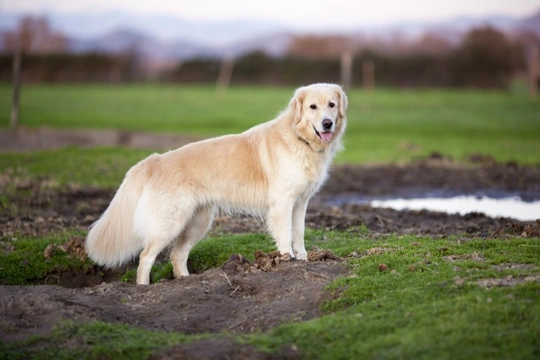
ICT-A (Ichthyosis) testing for the Golden retriever dog breed
Ichthyosis or ICT-A for short is a hereditary health condition that has been identified in the Golden retriever dog breed. Ichthyosis is a form of dermatitis of the skin, which occurs due to a gene mutation that causes the cells of the skin to malfunction, leading them to be larger than normal and often discoloured too.
The name of the condition comes from the Greek word for fish, because the abnormal cell growth that accompanies the condition can cause large, flaky scaling of the skin, which look somewhat like the scales of a fish.
Ichthyosis usually becomes apparent not long after an affected dog is born, and begins with the formation of large, white skin scales on the pup’s body, which continue to develop throughout the life of the dog and become progressively more scaly, rough and dry, and darker in colour too, sometimes nearly black.
However, despite the appearance of the condition, it is not itchy or painful for affected dogs, but secondary complications such as infections due to parasites or bacteria can occur on the abnormal skin cells, which can cause problems of its own.
The condition cannot be cured or reversed, and management of the condition usually involves keeping the dog’s skin and coat in good condition with regular brushing and grooming, as well as regular bathing with the use of rich emollient moisturisers too. Feeding a specialist or prescription diet that is high in essential fatty acids can help to some extent as well.
While dogs with the condition will never fully get rid of it, in some dogs, ichthyosis stabilises as the dog reaches old age, leading to a less pronounced appearance of the signatures of the problem.
As a hereditary health condition, ichthyosis can be passed on through the genes from parent dogs to their offspring, and a DNA test is available to check the status of any given dog prior to breeding.
In this article, we will look at ichthyosis in the Golden retriever in more detail, covering how the heredity of the condition works, and how to get your dog tested. Read on to learn more.
More about ichthyosis
Ichthyosis in the golden retriever tends to present with symptoms when the affected dog is still young, and can become apparent from as young as four weeks old. Generally by the time any given dog is 18 months old, the condition will begin to develop if it is going to.
Because the golden retriever has a very long, thick coat, the earliest symptoms of the condition are easy to overlook, as you have to get right down to the surface of the dog’s skin with a brush or a comb to spot the earliest signs of cellular changes in the skin.
Affected dogs tend to have significant amounts of dandruff in large flakes, particularly from the back, flanks and stomach area. The skin itself will look scaly and discoloured, which is again sometimes simply confused with the dog being in need of a good bath-however, bathing cannot remove the signature dark, scaly areas that the condition causes.
Ichthyosis is not painful for the affected dog, nor itchy, but it does raise the risk of the dog developing an infection of the skin, and of course, takes time and funds to manage.
What sort of dogs can be affected by the condition?
Ichthyosis is unique to the golden retriever when it comes to pedigree dogs, and outcrossing a golden retriever to another breed introduces the benefits of hybrid vigour, and makes it unlikely that a cross breed will inherit the affected form of the condition.
However, because the golden retriever breed is used in a range of different so-called designer or hybrid breeds like the goldendoodle, the condition may affect such hybrids if they have more than one golden retriever dog in their ancestry.
How does the heredity of the condition work?
Ichthyosis is inherited by means of autosomal recessive heredity, which means that the status of any given dog is determined by the combination of genes that they inherit from both parents, and not just one alone. Dogs are assigned a status of either clear, carrier or affected, and whilst carriers will not develop the condition themselves, they can still pass on the gene mutation that leads to it to their own offspring.
In order to determine the status of a litter or potential litter than will result from the match of any two dogs, the following formula can be used:
- Two clear dogs will have clear puppies.
- Two affected dogs will have affected puppies.
- Two carriers will have mixed odds of 50% carriers, 25% clear and 25% affected.
- A clear dog and a carrier will have 50% clear and 50% carriers.
- A clear dog and an affected dog will have a litter of carriers.
- A carrier and an affected dog will have 50% carriers and 50% affected.
How to get your Golden retriever tested for ichthyosis
In order to find out your dog’s status, you will need to ask your vet to take a DNA sample from your dog, which is then sent off to one of The Kennel Club’s approved laboratories for testing. They will then return the result of your dog’s status to you.



